Spring into Citizen Science Projects

Jacksonville Women’s History Month Spotlight: Nell L. Cowan Bostwick
March 18, 2022
The Vernal Equinox & the Egg-Balancing Myth
March 18, 2022Globe Observer: Trees
With the emerging spring season, trees are budding and sprouting new leaves. Invasive diseases and pests are threatening the health of our forests. Scientists need your help tracking healthy, resilient trees to study how they are unaffected by harmful diseases. Participants can record the location of healthy trees, so scientists can use the information to locate candidates for genetic sequencing and breeding programs. Take action to protect our forests, and start tagging trees using the TreeSnap app. Learn more here.
Globe Observer: Clouds
Do you ever find yourself passing time staring at the clouds drifting overhead? No matter their size or shape, clouds are an essential component of Earth’s natural system. Clouds act as an atmospheric blanket contributing to temperature regulation and providing precipitation. Join NASA and The GLOBE Program in this international initiative to better understand our global environment. Cloud observations help scientists track changes in clouds in support of climate research. Participate by photographing clouds and reporting sky observations to compare them with NASA satellite images. Learn more here.
Journey North
One sure sign of Spring is the appearance of Monarch butterflies. Around mid-March, the gentle creatures leave their roosts and begin the challenging migration north. Monarchs search for milkweeds along the journey, in which they lay their eggs. You can help track their migration patterns by submitting your observations to the Journey North website. This citizen science project is suitable for K – 12 students, teachers, families, and anyone looking for an opportunity to study wildlife migration and phenology. Learn more here.
Project Squirrel
Backyard critters are coming out of their dens in search of food this Spring. Squirrels can be found anywhere there is a tree. Help scientists understand tree squirrel ecology from your own backyard or nearby park. Learn how to identify the tree squirrel species, and then report your findings about their presence or absence and the ecological conditions in your area. Learn more here.
NestWatch by Cornell Lab of Ornithology
Any birders out there? NestWatch is a nationwide nest-monitoring project that helps scientists study bird biology and monitor populations of breeding birds. The data collected allows us to understand the impact of various threats on the winged creatures and how we can take the necessary steps to protect them in this constantly changing world. Nurture your bond with nature and monitor nests a few times a week. Materials and instructions are found here.


